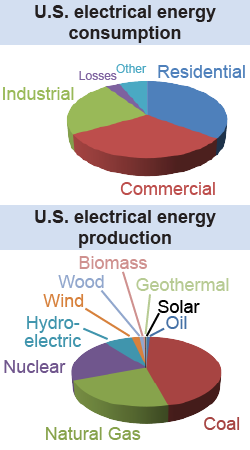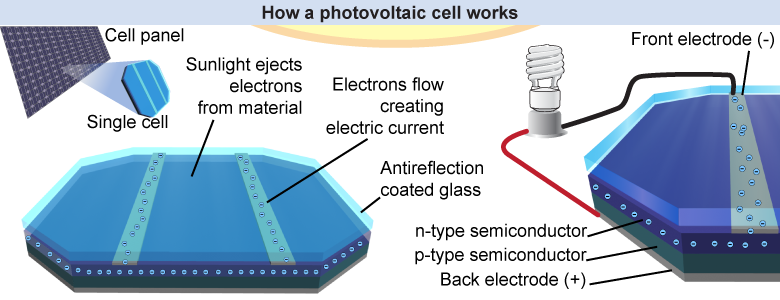|
On average, the USA uses about 4,000 terawatt–hours of electrical energy per year. About one-third of this energy powers our homes, including refrigerators, electric lights, tools, and appliances. Another one-third powers our businesses, schools, and stores. The remaining one-third powers our industries, such as car manufacturing, metal refining, textiles, machinery, and chemical manufacturing. Where does all the electrical energy come from? 
| 
|
Energy cannot be created but only transformed from one form into another. Today, about 70% of U.S. electrical energy is produced by generators that burn natural gas, coal, or oil. Most of the rest comes from nuclear reactors (20%) and hydroelectric dams (7%). A tiny fraction (<2%) comes from wind and an even tinier fraction (< 0.1%) comes from solar power. Energy consumption is plotted in the illustration at right. It is easy to infer from this pie chart that coal is the largest sector for energy production in the USA, because coal visually has the largest “wedge” in the pie chart. 
 |
In the big picture, all fossil fuels ultimately derive their energy from sunlight. Coal, oil, and natural gas are byproducts of sunlight captured by plants over millions of years. Even hydropower and wind power are ultimately derived from solar energy. 
|
Despite its small contribution today, many believe expanding solar power offers the best solution to providing more electricity while also limiting the negative environmental impacts of energy production. The Sun emits an enormous quantity of energy. Over a 24 hour period, an average of 250 joules per second (or watts) of sunlight reach each square meter of the ground. The USA has a land area of 9.2 million square kilometers, or 9.2×1012 m2. If each square meter receives 250 J/s, the average energy in sunlight falling on the USA is 2,280 trillion J/s. This is around 5,000 times the entire country’s average electric power use! So, at first glance, solar power appears to be an ideal, plentiful, and clean energy source. 
|

|
A photovoltaic cell (PV cell) transforms light directly into electrical energy. The basic physics of this process is fairly well understood. Light absorbed by a semiconductor p-n junction ejects electrons from certain atoms in the depletion region. The ejected electrons are collected and forced to flow through a circuit and carry electrical energy. 
|
What is the average amount of energy the USA uses each year, expressed in watt–hours (Wh)? - 4×103 Wh
- 4×106 Wh
- 4×1012 Wh
- 4×1015 Wh
 |
The correct answer is 4×1015 Wh.
One thousand is 103 and tera is 1012, so 4,000 terawatt–hours equal 4×1015 Wh. 
|
In a photovoltaic cell, how will the number of electrons ejected change if the intensity of the sunlight increases? How about after the Sun sets?
 |
The number of ejected electrons increases for higher intensity of sunlight. At night after the Sun sets, the number of ejected electrons effectively drops to zero. 
|
| |
|

